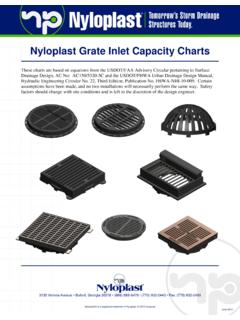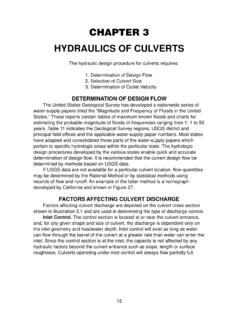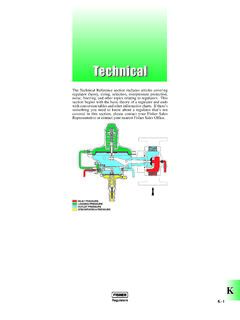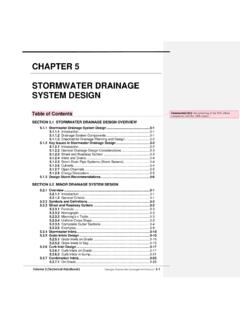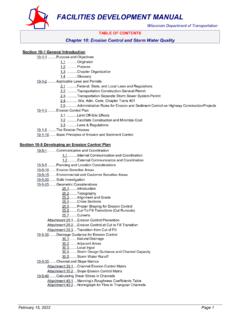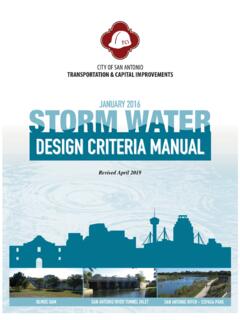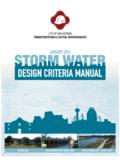Transcription of CHAPTER 5 CULVERTS - Michigan
1 CHAPTER 5 CULVERTS NOTE: All questions and comments should be directed to the Drainage Specialist, Design Support Area. Revised September 2009 CULVERTS 5-2 MDOT Drainage Manual CHAPTER Table of Contents Introduction/Purpose 5-5 Definitions 5-6 Policy and Design Criteria 5-9 Introduction 5-9 culvert Policy 5-11 culvert Pipe Class Designation 5-12 culvert Usage Guidelines 5-12 culvert Environmental Permit Requirements 5-13 culvert Design Considerations 5-13 End Treatment (Inlet or Outlet) 5-17 Pipe End Treatments 5-20 Boxes/Slab End Treatments 5-21 Weep Holes 5-23 culvert Extensions and Replacements 5-23 Bedding and Filling Around Pipe CULVERTS 5-25 Related Designs 5-25 Design Guidance and Procedure 5-26 Approach 5-26 Inlet Control 5-26 Outlet Control 5-29 Outlet Velocity 5-35 Roadway Overtopping 5-36 Performance Curves 5-37 culvert Design Procedure 5-38 Nomograph Design and Analysis 5-43 HY8 Computer Program 5-48 Overview 5-48 Data Input
2 5-48 CULVERTS 5-3 MDOT Drainage Manual Rating Curve 5-49 Roadway Data 5-51 Data Summary 5-52 Performance Curve (5 feet by 5 feet) 5-53 Performance Curve (6 feet by 6 feet) 5-54 Performance Curve (7 feet by 6 feet) 5-55 Minimize culvert Span of HY8 5-56 Overtopping Performance Curve (7 feet by 6 feet) 5-57 Review 5-58 Maintenance 5-59 culvert Maintenance and Inspection 5-60 Cleaning 5-60 Lining CULVERTS 5-60 References 5-62 Appendices 5-A Symbols and Acronyms 5-A-1 5-B Tables of Manning s n, Loss Coefficients.
3 And Worksheets 5-B-1 5-C culvert Design Charts 5-C-1 5-D culvert Documentation Forms 5-D-1 CULVERTS 5-4 MDOT Drainage Manual Figures 5-1 culvert Terms 5-6 5-2 Box culvert Invert Placement 5-16 5-3 Unsubmerged, Transition, and Submerged 5-27 5-4 Unsubmerged Flow 5-28 5-5 Submerged Flow 5-28 5-6 Full Flow Energy and Hydraulic Grade Lines 5-31 5-7 Full Flow in the culvert 5-33 5-8 Partly Full Flow 5-34 5-9 Partly Full Flow when Tw < dc 5-34 5-10 Partly Full Flow when Tw > dc 5-35 5-11 Overall Performance Curve 5-38 5-12 Chart 17 and Performance Curve for Design Example 5-45 Tables 5-1 Guidelines for culvert End Treatments within the Clear Zone 5-18 5-2 Equivalent Circular and Box culvert Sizes 5-24 CULVERTS 5-5 MDOT Drainage Manual INTRODUCTION/PURPOSE This CHAPTER provides design procedures for the
4 Hydraulic design of highway CULVERTS , which are based on FHWA Hydraulic Design Series Number 5 (HDS5), Hydraulic Design of Highway CULVERTS . This CHAPTER also: Presents results of culvert analysis using HY8 culvert analysis software, and Provides a summary of the design philosophy contained in the AASHTO Highway Drainage Guidelines, CHAPTER IV, Hydraulic Design of CULVERTS . CULVERTS 5-6 MDOT Drainage Manual DEFINITIONS Following are concepts important in culvert design. Several terms are shown in Figure 5-1, culvert Terms. Critical Depth - The depth at which the specific energy of a given flow rate is at a minimum. For a given discharge and cross-section geometry there is only one critical depth. Appendix 5-C at the end of this CHAPTER contains critical depth charts for different shapes. Crown - The highest interior elevation of a culvert , sewer, drain pipe, or tunnel. This may also be referred to as underclearance or low chord.
5 See Figure 5-1. Figure 5-1 culvert Terms culvert - A structure that is usually designed hydraulically to convey surface runoff through an embankment. The span is less than 20 feet. Energy Grade Line (EGL) - A line joining the elevation of energy heads; a line drawn above the hydraulic grade line a distance equivalent to the velocity head of the flowing water at each section along a stream channel or conduit. Flow Line - The lowest physical surface elevation in a drainage system. For storm sewers, the flow line is the same as the invert. This may not be true for CULVERTS that are recessed. See Figure 5-1. Flow Type - The USGS has established seven culvert flow types which assist in determining the flow conditions at a particular culvert site. Diagrams of these flow types are provided in the design methods, Section Free Outlet - An outlet that has a tailwater equal to or lower than critical depth.
6 For CULVERTS having free outlets, lowering of the tailwater has no effect on the discharge or the backwater profile upstream of the tailwater. CULVERTS 5-7 MDOT Drainage Manual Harmful Interference - MDEQ defines harmful interference as cause of an unnaturally high stage or unnatural direction of flow on a river or stream that causes, or may cause, damage to property, a threat to life, a threat of personal injury, or a threat to water resources. A working definition of harmful interference is any harm that may be caused to riparians including unnaturally low water stages. Hydraulic Grade Line (HGL) - A profile of the piezometric level to which the water would rise in piezometric line tubes along a pipe run. In open channel flow, it is the water surface. See Figure 5-1. Improved Inlet - An inlet that has an entrance geometry which decreases the flow contraction at the inlet and thus increases the capacity of CULVERTS .
7 These inlets are referred to as either side- or slope-tapered (walls or increased flow-line slope at the entrance) and sometimes are beveled edged. Inlet Control - Occurs when the culvert barrel is capable of conveying more flow than the inlet will accept. The control section of a culvert operating under inlet control is located just inside the entrance. Critical depth occurs at or near this location, and the flow regime immediately downstream is supercritical. Hydraulic characteristics downstream of the inlet control section do not affect the culvert capacity . The upstream water surface elevation and the inlet geometry represent the major flow controls. The inlet geometry includes the barrel shape, cross-sectional area, and the inlet edge. Invert - The lowest interior elevation of a culvert , sewer, or tunnel. See Figure 5-1. Mild Slope - Occurs where critical depth is less than normal depth.
8 Normal Depth - The depth at normal flow. Normal Flow - Occurs in a channel reach when the discharge, velocity, and depth of flow do not change throughout the reach. The water surface and channel bottom will be parallel. This type of flow will exist in a culvert operating on a constant slope, provided the culvert is sufficiently long and the tailwater is less than the normal depth. Ordinary Mean High Water Mark - The line on the shore of a waterway that is: Established by the fluctuations of water. Indicated by physical characteristics such as a clear and natural line impressed on the bank, shelving, changes in the character of the soil, the destruction of terrestrial vegetation, or the presence of litter or debris. CULVERTS 5-8 MDOT Drainage Manual Outlet Control - Occurs when the culvert barrel is not capable of conveying as much flow as the inlet opening will accept. The control section for outlet control flow in a culvert is located at the barrel exit or further downstream.
9 Either subcritical or pressure flow exists in the culvert barrel under these conditions. All of the geometric and hydraulic characteristics of the culvert play a role in determining its capacity : water surface elevation at the outlet, slope, length, and hydraulic roughness of the culvert barrel. Steep Slope - Hydraulically steep slopes occur where critical depth is greater than normal depth. Submerged Inlet - Occurs when the headwater is greater than where D is the culvert diameter or barrel height. Submerged Outlet - Occurs when the tailwater elevation is higher than the crown of the culvert . A list of symbols and acronyms used in this CHAPTER is given in Appendix 5-A. CULVERTS 5-9 MDOT Drainage Manual POLICY AND DESIGN CRITERIA Introduction The design of a culvert system for a highway crossing of a floodplain involves using information from the other chapters in this manual and should be referenced when necessary.
10 CULVERTS shall be selected which satisfy: topography, and design policies and criteria. CULVERTS shall be analyzed for: environmental impact, harmful interference, hydraulic equivalency, and risk and cost. Select a culvert which best integrates engineering, economic, and environmental considerations. The chosen culvert shall meet the selected structural and hydraulic criteria and shall be based on: construction and maintenance costs, risk of failure or property damage, traffic safety, environmental or aesthetic considerations, political or nuisance considerations, and land use requirements. Structure Types to Consider culvert Is a covered structure with both ends open. Designed using procedures of HDS5. Storm Drain (See CHAPTER 7, Road Storm Drainage Systems) Is a covered structure with either end in a manhole or other structure and is usually a part of a system of pipes.










